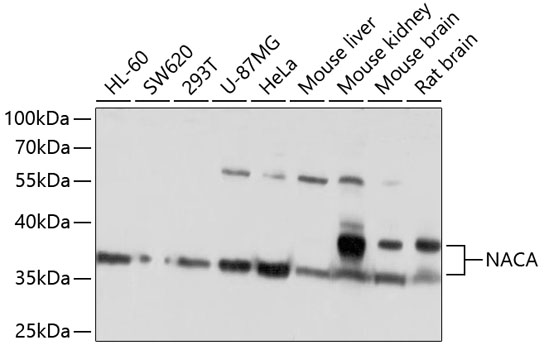Anti-NACA Antibody (CAB10122)
- SKU:
- CAB10122
- Product type:
- Antibody
- Reactivity:
- Human
- Mouse
- Rat
- Host Species:
- Rabbit
- Isotype:
- IgG
- Antibody Type:
- Polyclonal Antibody
- Research Area:
- Cell Biology
Frequently bought together:
Description
| Antibody Name: | Anti-NACA Antibody |
| Antibody SKU: | CAB10122 |
| Antibody Size: | 20uL, 50uL, 100uL |
| Application: | WB IHC IP |
| Reactivity: | Human, Mouse, Rat |
| Host Species: | Rabbit |
| Immunogen: | Recombinant fusion protein containing a sequence corresponding to amino acids 1-215 of human NACA (NP_001106673.1). |
| Application: | WB IHC IP |
| Recommended Dilution: | WB 1:500 - 1:2000 IHC 1:50 - 1:100 IP 1:50 - 1:100 |
| Reactivity: | Human, Mouse, Rat |
| Positive Samples: | HL-60, SW620, 293T, U-87MG, HeLa, Mouse liver, Mouse kidney, Mouse brain, Rat brain |
| Immunogen: | Recombinant fusion protein containing a sequence corresponding to amino acids 1-215 of human NACA (NP_001106673.1). |
| Purification Method: | Affinity purification |
| Storage Buffer: | Store at -20°C. Avoid freeze / thaw cycles. Buffer: PBS with 0.02% sodium azide, 50% glycerol, pH7.3. |
| Isotype: | IgG |
| Sequence: | MPGE ATET VPAT EQEL PQPQ AETG SGTE SDSD ESVP ELEE QDST QATT QQAQ LAAA AEID EEPV SKAK QSRS EKKA RKAM SKLG LRQV TGVT RVTI RKSK NILF VITK PDVY KSPA SDTY IVFG EAKI EDLS QQAQ LAAA EKFK VQGE AVSN IQEN TQTP TVQE ESEE EEVD ETGV EVKD IELV MSQA NVSR AKAV RALK NNSN DIVN AIME LTM |
| Gene ID: | 4666 |
| Uniprot: | Q13765 |
| Cellular Location: | Cytoplasm, Nucleus |
| Calculated MW: | 23kDa/94kDa/205kDa |
| Observed MW: | 37kDa |
| Synonyms: | NACA, HSD48, NAC-alpha, NACA1, skNAC |
| Background: | This gene encodes a protein that associates with basic transcription factor 3 (BTF3) to form the nascent polypeptide-associated complex (NAC). This complex binds to nascent proteins that lack a signal peptide motif as they emerge from the ribosome, blocking interaction with the signal recognition particle (SRP) and preventing mistranslocation to the endoplasmic reticulum. This protein is an IgE autoantigen in atopic dermatitis patients. Alternative splicing results in multiple transcript variants, but the full length nature of some of these variants, including those encoding very large proteins, has not been determined. There are multiple pseudogenes of this gene on different chromosomes. |
| UniProt Protein Function: | NACA: Prevents inappropriate targeting of non-secretory polypeptides to the endoplasmic reticulum (ER). Binds to nascent polypeptide chains as they emerge from the ribosome and blocks their interaction with the signal recognition particle (SRP), which normally targets nascent secretory peptides to the ER. Also reduces the inherent affinity of ribosomes for protein translocation sites in the ER membrane (M sites). May act as a specific coactivator for JUN, binding to DNA and stabilizing the interaction of JUN homodimers with target gene promoters. Belongs to the NAC-alpha family. Interacts with TBP and JUN. Part of the nascent polypeptide-associated complex (NAC), consisting of NACA and BTF3. NAC associates with ribosomes through the BTF3 subunit. Both subunits can contact nascent polypeptide chains. Interacts with ASFV protein H339R. |
| UniProt Protein Details: | Protein type:Transcription, coactivator/corepressor; Motility/polarity/chemotaxis Chromosomal Location of Human Ortholog: 12q23-q24.1 Cellular Component: cytoplasm; nascent polypeptide-associated complex; nucleus Molecular Function:DNA binding; protein binding; transcription coactivator activity Biological Process: positive regulation of skeletal muscle growth; protein transport; regulation of skeletal muscle fiber development; regulation of transcription, DNA-dependent; skeletal muscle regeneration; transcription, DNA-dependent; translation; viral reproduction |
| NCBI Summary: | This gene encodes a protein that associates with basic transcription factor 3 (BTF3) to form the nascent polypeptide-associated complex (NAC). This complex binds to nascent proteins that lack a signal peptide motif as they emerge from the ribosome, blocking interaction with the signal recognition particle (SRP) and preventing mistranslocation to the endoplasmic reticulum. This protein is an IgE autoantigen in atopic dermatitis patients. Alternative splicing results in multiple transcript variants, but the full length nature of some of these variants, including those encoding very large proteins, has not been determined. There are multiple pseudogenes of this gene on different chromosomes. [provided by RefSeq, Feb 2016] |
| UniProt Code: | Q13765 |
| NCBI GenInfo Identifier: | 767974358 |
| NCBI Gene ID: | 4666 |
| NCBI Accession: | XP_011536691.1 |
| UniProt Related Accession: | Q13765,E9PAV3 |
| Molecular Weight: | Calculated MW: 23kDa/94kDa/205kDaObserved MW: 37kDa |
| NCBI Full Name: | nascent polypeptide-associated complex subunit alpha isoform X3 |
| NCBI Synonym Full Names: | nascent polypeptide-associated complex alpha subunit |
| NCBI Official Symbol: | NACA |
| NCBI Official Synonym Symbols: | HSD48; NACA1; skNAC; NAC-alpha |
| NCBI Protein Information: | nascent polypeptide-associated complex subunit alpha |
| UniProt Protein Name: | Nascent polypeptide-associated complex subunit alpha, muscle-specific form |
| UniProt Synonym Protein Names: | Alpha-NAC, muscle-specific form; skNAC |
| Protein Family: | Nascent polypeptide-associated complex |
| UniProt Gene Name: | NACA |
| UniProt Entry Name: | NACAM_HUMAN |










